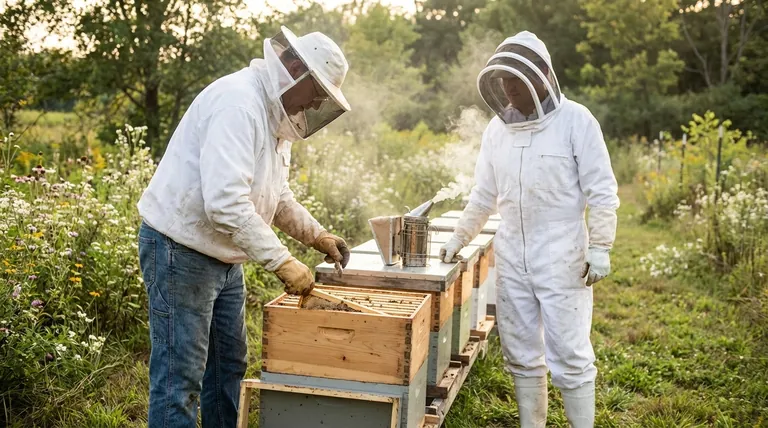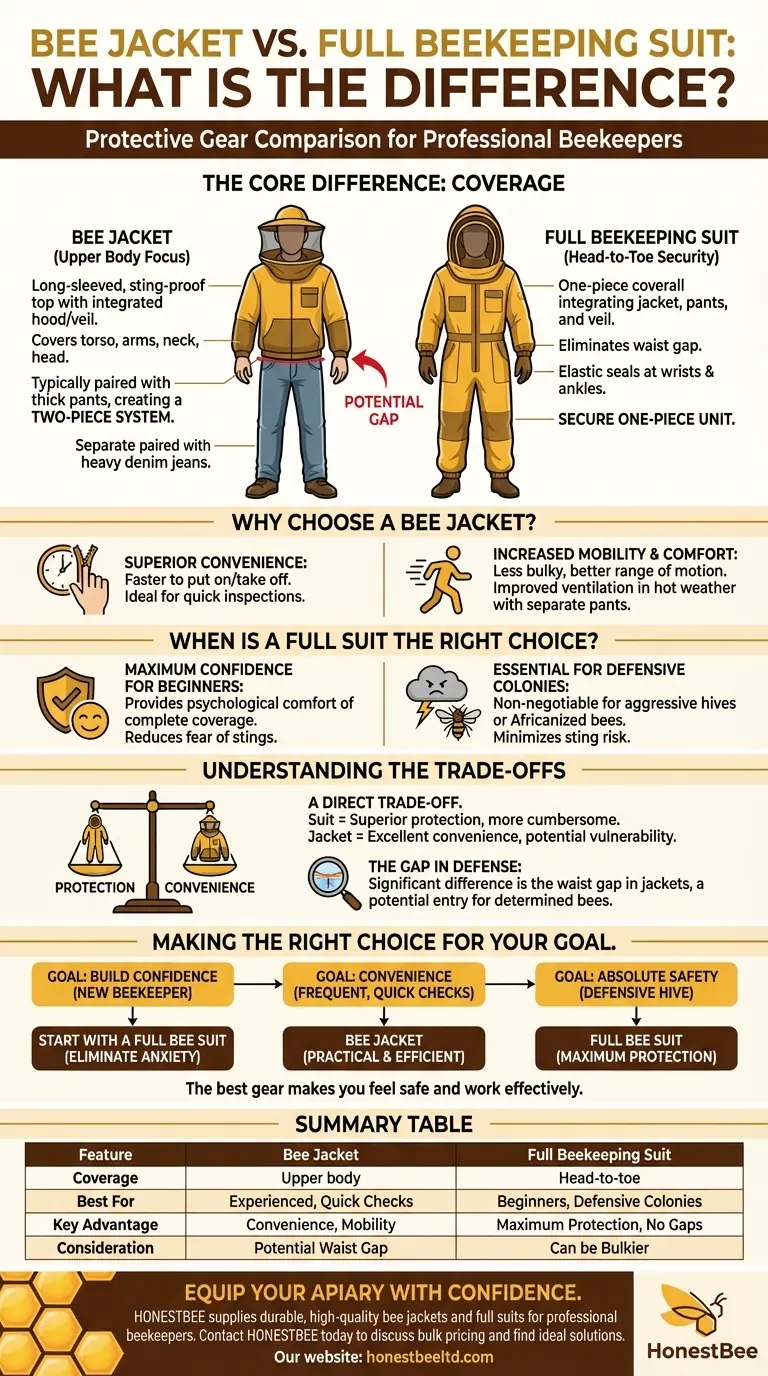At its core, a bee jacket is protective gear for your upper body, while a full beekeeping suit is a one-piece garment providing head-to-toe coverage. A jacket consists of a long-sleeved, sting-proof top with an integrated hood and veil. In contrast, a full suit combines the jacket, pants, and veil into a single zip-up unit, leaving no gaps at the waist.
The choice between a bee jacket and a full suit is not about which is universally "better," but about a personal calculation of risk, comfort, and convenience for your specific beekeeping context. It's a direct trade-off between absolute protection and ease of use.

The Fundamental Difference: Coverage
The primary distinction between these two essential pieces of equipment is the amount of your body they protect.
The Bee Jacket: Upper Body Focus
A bee jacket is essentially a heavy-duty hoodie with a beekeeper's veil attached. It covers your torso, arms, neck, and head.
Beekeepers typically pair a jacket with thick, durable pants like heavy denim jeans to protect their lower body. This creates a two-piece system.
The Full Suit: Head-to-Toe Security
A full beekeeping suit is a one-piece coverall. It integrates the pants and jacket into a single garment.
This design eliminates the gap at the waist, which is a potential entry point for bees. Elastic bands at the wrists and ankles create a secure seal for maximum protection.
Why Choose a Bee Jacket?
Many experienced beekeepers prefer a jacket for its practicality in day-to-day work.
Superior Convenience
A jacket is significantly faster and easier to put on and take off than a full suit. For quick hive inspections or simple tasks, this convenience is a major advantage.
Increased Mobility and Comfort
Without the bulk of integrated pants, a jacket can feel less cumbersome and offer a greater range of motion. In hot weather, wearing a jacket with separate pants can also provide better ventilation.
When is a Full Suit the Right Choice?
A full suit offers a level of security that is essential in certain situations.
Maximum Confidence for Beginners
For new beekeepers, the fear of being stung can be a significant hurdle. A full suit provides the psychological comfort of complete coverage, allowing you to focus on learning to work with the bees calmly and confidently.
Essential for Defensive Colonies
If you are working with a particularly aggressive or "hot" hive, or in an area known for defensive bees like Africanized Honey Bees, a full suit is non-negotiable. Its seamless design minimizes the risk of stings from a highly agitated colony.
Understanding the Trade-offs
Choosing your protective gear involves balancing competing priorities. There is no single right answer, only the right answer for your situation.
Protection vs. Convenience
This is the central trade-off. The full suit offers superior, nearly foolproof protection at the cost of being more cumbersome and taking longer to get into. The jacket offers excellent convenience but introduces a potential vulnerability at the waist.
The Gap in Defense
The most significant physical difference is the gap between a jacket and your pants. While tucking a jacket in and wearing a belt can mitigate this, it remains a potential entry point for a determined bee that a one-piece suit eliminates entirely.
Making the Right Choice for Your Goal
Your final decision should be based on your experience, the temperament of your bees, and your personal comfort with risk.
- If your primary focus is building confidence as a new beekeeper: Start with a full bee suit to eliminate any anxiety about stings and focus on learning.
- If your primary focus is convenience for frequent, quick hive checks: A bee jacket is likely the more practical and efficient choice for an experienced beekeeper.
- If your primary focus is absolute safety with a known defensive hive: A full bee suit is the only responsible option to ensure maximum protection.
Ultimately, the best protective gear is the one that makes you feel safe and allows you to work with your bees effectively.
Summary Table:
| Feature | Bee Jacket | Full Beekeeping Suit |
|---|---|---|
| Coverage | Upper body (torso, arms, head) | Head-to-toe (full body) |
| Best For | Experienced beekeepers, quick checks, hot weather | Beginners, defensive colonies, maximum safety |
| Key Advantage | Superior convenience, mobility, and ventilation | Maximum protection, no gaps, confidence for beginners |
| Consideration | Potential gap at the waist | Can be bulkier and less ventilated |
Equip Your Apiary with Confidence
Whether you manage a large commercial operation or supply distributors, having the right protective gear is non-negotiable for safety and efficiency. HONESTBEE supplies durable, high-quality bee jackets and full beekeeping suits designed for the demands of professional beekeepers.
We understand that your choice impacts your team's confidence and productivity. Let us help you select the perfect gear for your specific needs.
Ready to enhance your beekeeping operations? Contact HONESTBEE today to discuss bulk pricing and find the ideal protective solutions for your apiary.
Visual Guide

Related Products
- Economy Polyester Beekeeping Jacket with Veil and Hat
- Beekeeping Jacket with Hood and Veil for Beekeepers
- Beekeeping Gloves Goatskin Leather with Long Cotton Sleeve for Beekeepers
- Long Langstroth Style Horizontal Top Bar Hive for Wholesale
- Professional Engraved Round Hive Number Tags for Beekeeping
People Also Ask
- What are the main types of protective clothing worn by beekeepers? Choose the Right Gear for Maximum Safety
- What is the key factor in choosing between a bee jacket and a full bee suit? Find Your Perfect Fit for Beekeeping Safety
- What are the key features of a good beekeeping jacket? Unlock Confidence and Comfort at the Hive
- Can a bee sting through a bee suit? Understanding Sting-Resistant Protection
- What are the pros of using a beekeeping jacket? Unlock Superior Comfort and Mobility for Your Apiary



















